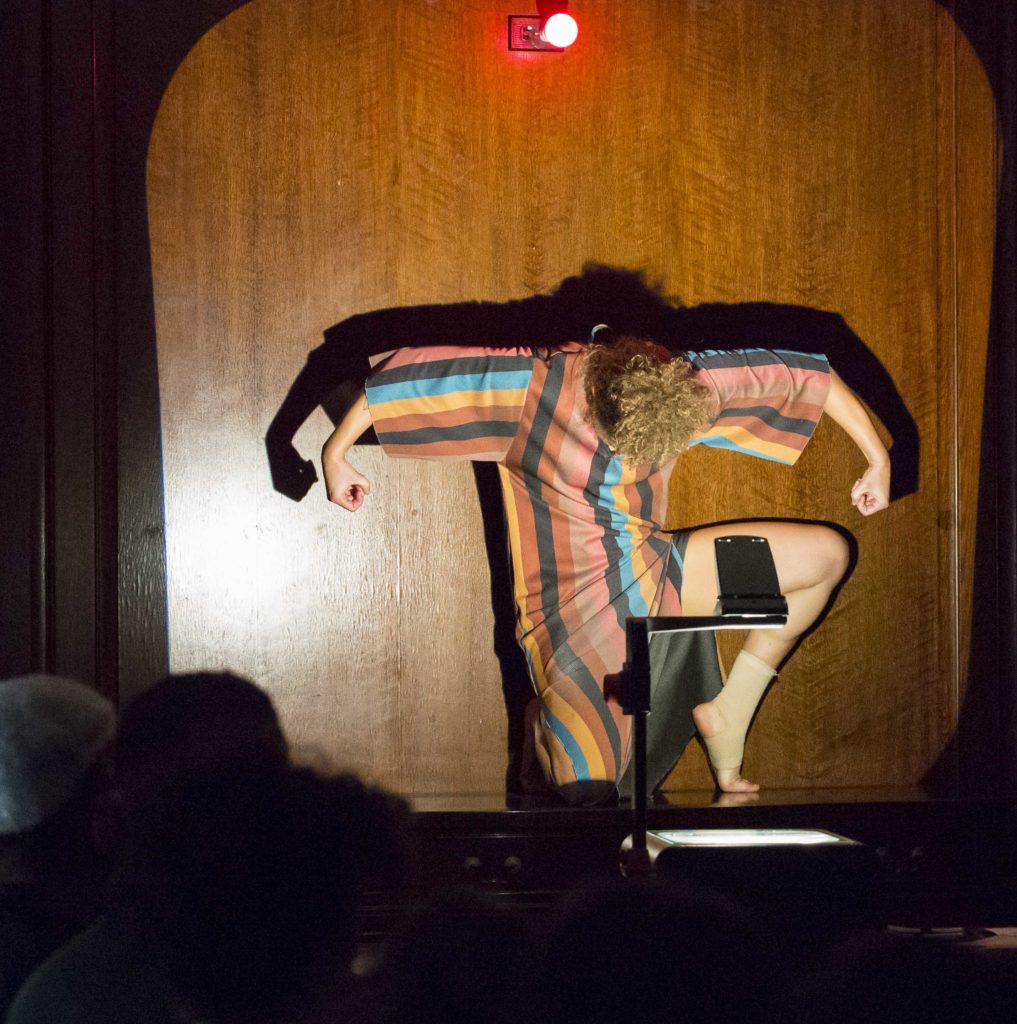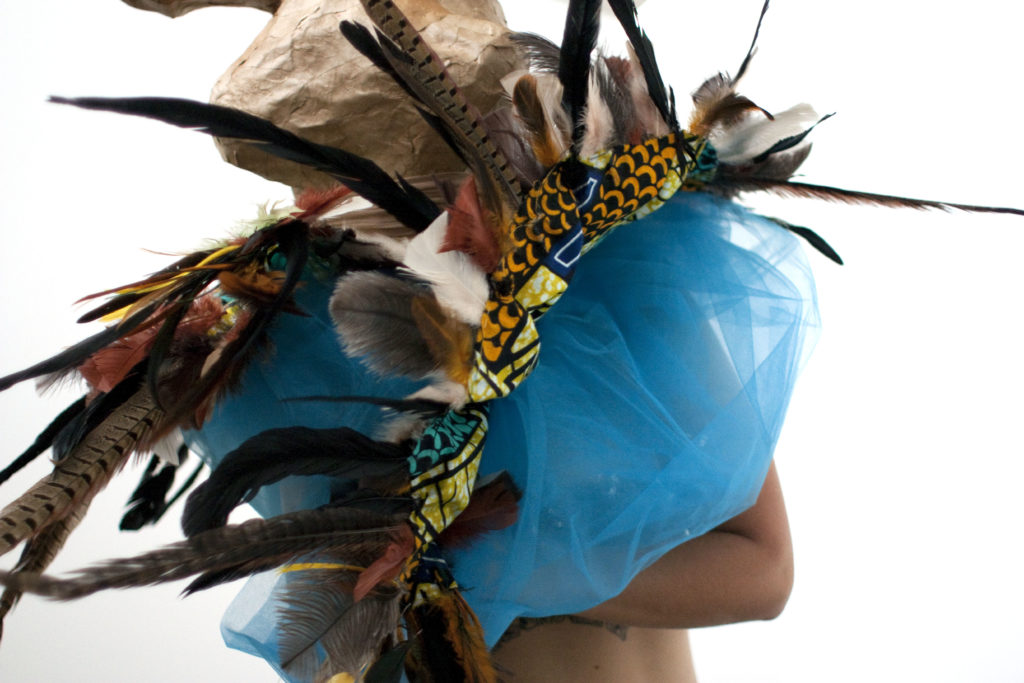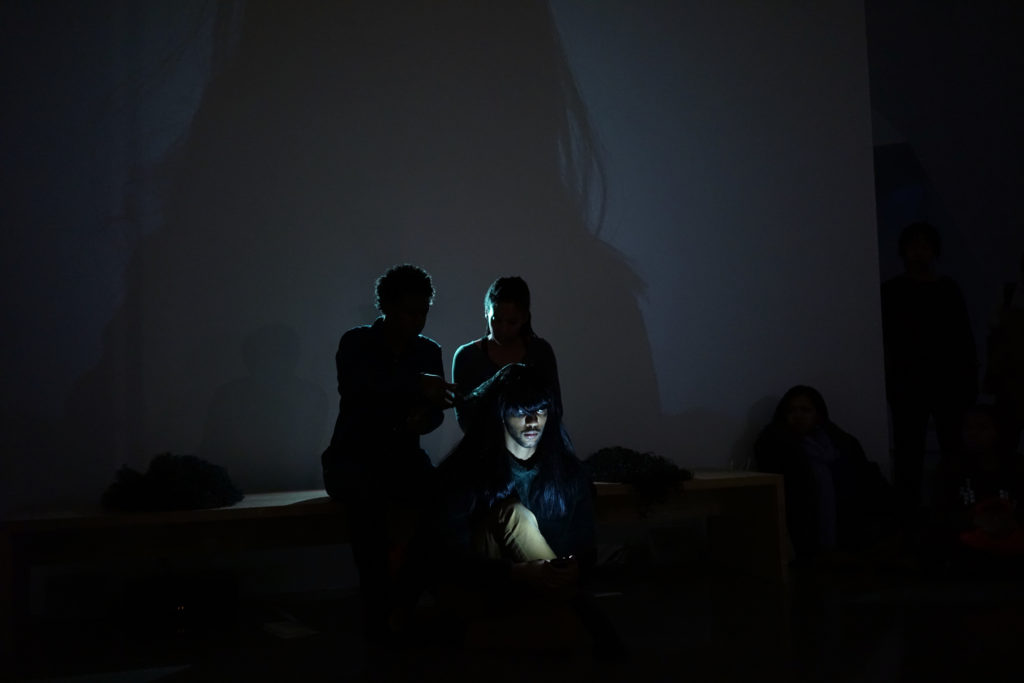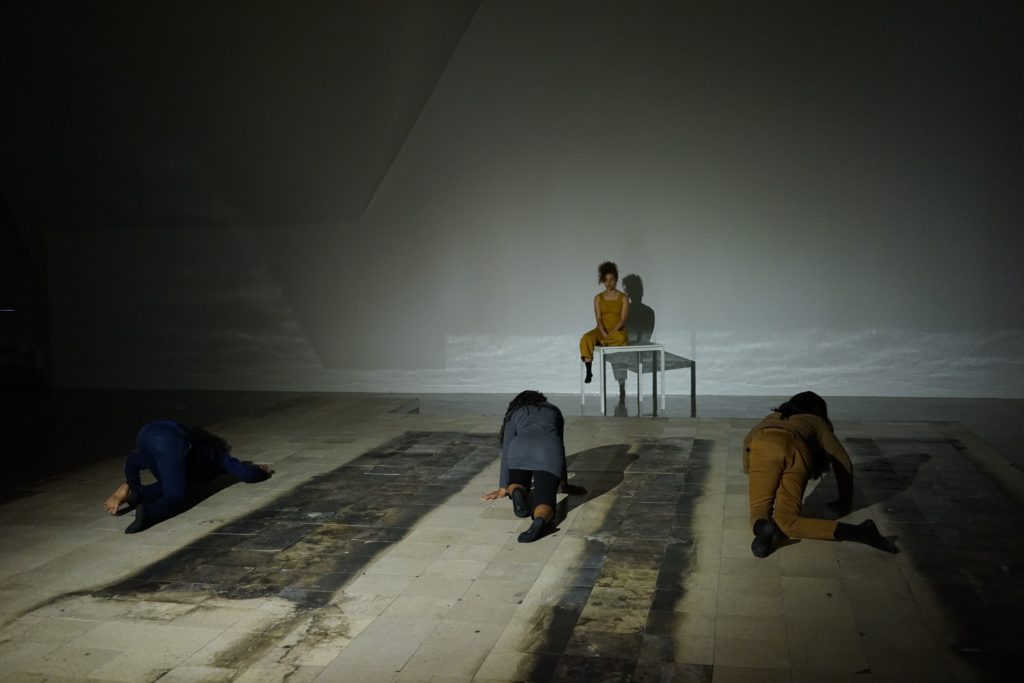The Panoptic Loop: Anna Martine Whitehead
by Mary L. Coyne

On a windy evening, I spoke with Chicago-based dance artist Anna Martine Whitehead, who recently completed a residency at the Museum of Contemporary Art Chicago (MCA). The following transcription traces our conversation, which considers the landscape of dance and performance venues both in Chicago and throughout the United States, the phenomena of performance within the museum setting, and Whitehead’s ongoing, and multi-faceted work Notes on Territory.
Mary L Coyne: We could start by talking about the MCA, where you most recently were an artist in residence as part of Groundings, on view through June 3, 2019. What did that look like?
Anna Martine Whitehead: Yes—it was many things. The research that I am currently doing is about bodies and their relationship to space. Being at the MCA for a week put my body in a very intimate and charged relationship to the institution; I had a lot of time to think about what a body—an artist’s body, or a body that is art—is within the context of a warehouse of art objects.
MC: To be a resident is to inhabit or live somewhere. What did you try and take away from a residency experience?
AMW: It is dawning on me that “residency” has the connotation of privacy, and maybe even of being hidden. This is the way I work, I guess: very secretively! Or maybe just interiorly. For better or worse. So, what is a residency when your residency hours are coordinated with the open-to-the-public hours of the institution, when there is no “away” to retreat to, when Black bodies are always already in a “public” role—but even more so in the Art institution (with a capital A), where there are so few bodies of color? I am thinking for some reason about E.J. Hill’s performance this past summer at the Hammer Museum, where he stood on a podium throughout the entire run of the show without taking breaks. I had a hard time with that piece because his body was so public. On the other hand, there was a kind of inscrutability to that performance. I know he was in a kind of meditative state the whole time—a deeply interior state. I never thought of it before, but it strikes me that his piece in that show was the definition of being Black, or being a performer, or being a performer of color in relation to the institution. Both hyper-visible, and also necessarily impenetrable.
MC: What does performance in the museum context mean to you? You have done a lot of it.
AMW: [laughs] Have I? That is funny, I do not think about that.
MC: It is where the art economy is in some ways—as opposed to a movement studio.
AMW: While that is not how I think of myself or my work, perhaps that is true. I just did the work at the MCA, and have a date upcoming at a performance venue called the Jam Handy in Detroit. The more I learn about Detroit, the more I am fascinated by it. There is a burgeoning performance economy there that follows the civic and community structures of the city—horizontally structured, somewhat hard to pin down, and very community-powered. I have also presented work within the San José Museum, The Hammer, the Chicago Cultural Center—so, it is true, I do a lot of things in galleries and museums.
In a piece that I am working on right now, I am trying to figure out where it is supposed to be. It is a lecture, and it is a dance, and there is a structure that has to live alongside it.
MC: This is Notes on Territory?
AMW: Yes. It elides categorization. In some ways, it does not make any sense for it to be held within a tradition theater space, but there are really nice things about theater settings.
MC: Theaters are so malleable; they can become anything that you want them to become.
AMW: Right—Lately, I have been reading Timothy Morton’s Hyperobjects, and am also assigning my students Parable of the Sower by Octavia Butler, so I’m re-reading it. I have been thinking a lot about what is coming and what is happening.
Last fall, I had a show at the Institute of Cultural Affairs Green Rise Building—a giant old building in Uptown, which was amazing—the site was host to a number of non-profits, but also a few communities that have been living there for decades. Julieanne Ehre, who runs Pivot Arts organized this opportunity—she is so invested in finding ways to bring art in Chicago to alternative spaces.
We performed on the same floor as one of those communities—the kitchen was across the hall from us, and on the sixth floor of the building where the green room was, there was a fish pond inside the room. Through this context, as an old beautiful art deco building where people are still living, I really had to make work in the space while maintaining its integrity. The experience felt more like what continues to make sense to me; it is a building that has a function, and its function is not to support me or my work—but we could exist within a mutually supportive situation for one week. I liked that.
MC: There are not many spaces like that. We have theaters which are kind of the blank slates to do whatever you need to do; theaters are built to support a fantasy. In this way, it is interesting for work that was made in one context to be brought into a museum—
AMW: Yes, it is challenging—taisha paggett’s piece at the Hammer was perfect for that reason.
MC: It was made for that space.
AMW: Yes. There is a part of Notes on Territory which is similar to Trajal Harell’s Antigone (2012) piece which has the small, medium, large. We figured out an “extra small version,” which is basically this thing that me and Damon Locks do where we just dance for thirty minutes. It has meaning, but I feel like what is happening is very site-specific. We can do that piece anywhere and it will be its own thing.

MC: How is Notes on Territory being shaped? You have presented it in different variations in different places—I have had the opportunity to see two or so iterations, and each has been so different. Beyond this, how do you think text has fit into your movement research?
AMW: First, I want to share a phone call I had this morning with Sarah Dahnke, who does a program called Dances for Solidarity. She has been doing this for four or five years, which is basically a correspondence project in which she creates a choreography with people who are in solitary confinement. This is so exciting to me, as I have been working with folks at Stateville prison for the past two and half years, through the Prison + Neighborhood Art Project. I am actually making choreography, which is so hard. Thinking about score is so hard. I would really like to teach a score class—I feel like nobody does that, and it is really important.
MC: Right, ‘score’ is a term we use so often, almost colloquially. But how do you start at the beginning and format a score for the movement you develop?
AMW: Especially for artists for whom performance is not their primary medium, it is really nice to acknowledge that the performance has a material to it. It can exist. It does not have to be a weird thing that artists do as an aside to their actual practice.
MC: And it does not have to be live—
AMW: Exactly. There is the challenge of the score, but there is also the challenge of getting the dance from inside the prison outside the prison, which is really hard. That is why the score is important. I am hoping to be talking with [Dahnke] for a long time. I am also hoping that the show I am doing in March—which will include a reading room called Freedom Futures Lab—will function as a workshop but also a space where people can come and think about the ideas contained within Notes on Territory outside of its existence as a live, abstract, poetic art piece. To instead establish an embodied, reflective, and intimate relationship with viewers.
I am hoping to receive some of the scores that the folks Dahnke has been working with have made. There are so many reasons why I am excited about the work she and her collaborators are doing—it is really impressive to see people’s actual marks, how they decide to make the work, and what they think the language of the work looks like on paper.
The scores then get set on dancers. For example, Dahnke has taught the scores to a group of youth who were on probation and parole in New Orleans, and worked with them as they learned the dance that somebody else had made while in prison. There are so many things about this that to me are immensely Sci-Fi and post-body; you can literally be in a “no-place,” where people do not think about you, and yet you have a hyper-raced, classed, gendered body. But also, you are ‘disappeared’ and I am fascinated by how that can exist on a totally other body—which in some ways, is “another body,” but is out in the world and visible. My hope is that is that we can have a score for people in Detroit to come and have some embodied freedom experience.

In Notes on Territory, there is so much talking in the performance—part of my interest in using text is that I just want to say some things. If there is a synopsis of this piece, it would be “everything is everything and nothing.” That should be on my tombstone, “everything is everything and also nothing.” And there is a way that the language makes that statement to be true as well. For example, there is a through line in the script which is about factories: the factory is a thing in space—a place that makes thing. It works into the future to produce another thing. Yet, it also works into the past and renders whatever comes into that factory into raw material. A cow becomes meat. I spend a lot of time talking about slave castles. They were called factories. A human gets turned into a slave but also a human gets turned into raw material. What is interesting about the ‘factory’ is that the term is derived from a line of work whose title was “factor,” meaning a merchant officer. When they first started building these slave castles in pre-colonial Africa, each of the officers that would be in this place were called ‘factors,’ and the buildings, ‘factories.’ At some point in the sixteenth to seventeenth-century the term factory started to mean the thing we understand it as today. Which could be, but is likely not, coincidental. —
In my work, I am trying to loop back to the various meaning of that word, but also how that word works in multiple directions of time and space. I like the way that language can get really confusing when you do that.
MC: How did Notes on Territory come to be?
AMW: Two things happened. I had the LinkUP residency at the University of Urbana-Champaign, and I found a book in which Samia Henni had a piece on Women in the Algerian Revolution having their headscarves forced off. She was looking at the Françaisation of these people; they had to have ID photographs taken and remove their headscarves for the photo (much like things that happen recently, actually). Henni talked about tan lines, how your skin could be weathered around the eyes and young on the cheeks. But what she was also looking at was the relationship between architecture and modern warfare. Shortly after that residency, I went to visit a friend in Paris, and we ended up at the Church of the Abbey of Saint-Germain-des-Prés. The church is beautiful and was built in the sixth-century, before there was theater—the light changes over the course of the hour. I found out that the church was located at the heart of an abbey, and in the abbey there was a prison. Why have a prison in the abbey? I could not find the prison on any map. The prison was built in the sixteenth-century, yet it was not until right before the French Revolution, in the late eighteenth-century, that you can finally find the prison on a map. And even then, it was poorly rendered. Both things happened at the same time: thinking about architecture in relationship to containment and war and population control.
That is the question of this piece: where is it? On the one hand, you understand that built space is intrinsic to organizing and controlling people, but on the other hand, you cannot have an image of the damn space. That is my question.
MC: It is the ultimate Foucauldian question.

AMW: That is what the Prison Industrial Complex is. We are going to monitor you forever, you are forever visible, and yet, where are you? I think of that every time I come back from Stateville prison, driving back to the beautiful Chicago skyline and the sun is shining, and I think, “I literally could have been in outer space.” It feels so absently different. I cannot imagine, when I am here, that a place like that is anywhere. And it feels like a spiral, which is why this piece seems never-ending.
MC: To go back to Foucault, he also reflected upon the relationship of the museum and the prison as being two sides of the same coin, although on opposite ends of a spectrum. Both are about visibility: being seen, or being hidden. When the museum becomes visible, the prison falls into an invisible sphere. People disappear.
AMW: That is why that map was so interesting actually. It is actually right there. This prison, Riker’s Island, San Quentin, you can see them.
MC: But social consciousness erases them from our sight lines.
AMW: Exactly. But I have not been interested in controlling the expansiveness of this idea, so therefore, it is something I keep working on.
MC: I like that. Most of us get to a point and then dial it down and distill it. But to let it keep going? Maybe that is the territory part? A frontier.
AMW: It does not stop. But it has to stop and it is going to stop this year. That why there is the “extra small version.” But there it also a part where it is really fun to think about architecture and dance and play cool music. Dancing is fun is also part of the story.
MC: And it is also okay. Dance and language can be fun.
AMW: Have you ever seen the film Synekdoche, New York? That movie is basically the story of my life, and the story of Notes on Territory. My collaborator, Damon Locks, was the one who suggested I see it. In that movie, which was one of the last movies Phillip Seymour Hoffman was in before his death, he plays a director that wins a genius grant and spends the rest of his life making a play that he requires is rehearsed 24 hours a day. It is about everybody in his life. And there is a scene in which one of the actors says to the director: “Caden, we’ve been rehearsing for seventeen years, when are we going to get an audience?!”